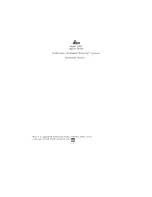
Quieter envelope is produced when transitioning from zone
1 to 3 or back.
Modulating the DRUM MOD socked does not trigger the
NOISES output but modulating the PITCH MOD does.
It means that by modulating these inputs, DRUMS and
NOISES can be triggered independently.
These patch points can be useful to set the FEED pin.
“+” can be used to offset any modulation signal and “-”
connects directly to ground so it can be used to connect
grounds between several instruments.
Tempo sets the speed of the modulation. The modulation is
displayed by an LED close to the TEMPO knob. A modulation
signal can be connected to the TEMPO MOD socket and
the TEMPO MOD knob sets the amount of the modulation.
This is especially useful when creating more complex
modulation curves.
The LFO socket outputs triangle waveform, but it can be
altered by modulating TEMPO or triggering the CLK IN to
get some complex modulation shapes.
The CLK output socket outputs a pulse wave in sync with
the LFO triangle wave. When the LFO triangle wave is
rising, the PULSE output is high and when it is falling, the
output is low. This signal can be used for synchronising
external equipment or modulating any of the parameters
on the Kastle.
The PATTERN generator is inspired by the Rungler circuit by
Rob Hordijk. It can produce 8 different voltages. It generates
new voltage four times per period of the LFO. When FEED
is not connected, the PATTERN output generates a 16-step
pattern. When it is low (or connected to “-” patch point), it
























